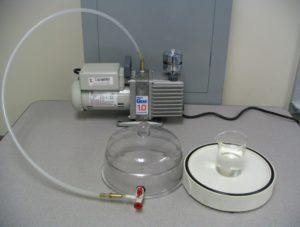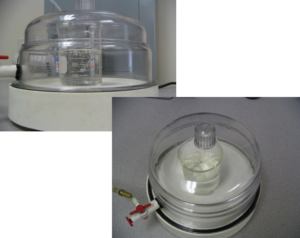Model Description
This demonstration is designed to show that the boiling point temperature of water is dependent on the pressure. This demonstration should take 8-10 minutes.
Engineering Principle
Most students are familiar with the process of boiling water on a stove, but this demonstration will show that the phase change is dependent on both pressure and temperature. This demonstration is best used in a Thermodynamics course when the topic of thermodynamic properties of water, saturation temperature and saturation pressure, the vapor dome, and the property tables for water are introduced. It is designed to provide students with a basic understanding of saturation pressure and saturation temperature and illustrate the dependence of the properties Pressure and Temperature when a substance is undergoing a phase change.
What You Need
| Item | Quantity | Description/Clarification |
|---|---|---|
| Vacuum Chamber | 1 | Container with a clear plastic lid, exit port, and rubber seal between the base and the lid. |
| Vacuum Pump | 1 | Electric-powered vacuum pump. |
| Plastic Tubing | 1 | Connects vacuum pump to the pressure chamber. |
| Glass beaker with water | 1 | Water should be lukewarm or warm depending on the strength of the vacuum pump. |
How It’s Done
Before Class: Have the components set up in the classroom.

In Class: Discuss the boiling point of water. Students are familiar with boiling water on a stove and will usually answer that the boiling temperature of water is 100° Celsius. Point out that the correct answer must include “at one atmosphere pressure”. Point out that water boils at a lower temperature at high altitudes where the atmospheric pressure is lower and at higher temperatures when pressures are above atmospheric pressure. Introduce the demonstration by asking how we can get the water in the beaker to undergo a phase change. We can either use a hot plate to raise the temperature of the water to 100°C, or we can reduce the pressure around the beaker of water low enough that the water will boil at it’s current temperature (figure below, upper).

Observations: Students should be able to see vapor bubbles forming in the water in the beaker and then the water come to a rolling boil as the vacuum pump is turned on and evacuates the air from the pressure chamber (figure above, lower).
Additional Application: To increase the suspense, put a cover over the vacuum pump and tell the students that you are going to boil water with a mystery device. Once the water has come to a rolling boil, release the pressure, lift off the cover and pick up the beaker with an oven mitt. Take it around the class and have a brave volunteer check the water temperature by sticking their finger into the beaker. After this demonstration, discuss saturation temperature and saturation pressure and the dependence of those properties during a phase change of a substance. Next, introduce the water property tables in the back of the Thermodynamic textbook and provide several examples such as using a pressure cooker at high altitudes, vacuum cooling of vegetables, and refrigerants used in air conditioning and refrigeration. Finally, use various combinations of temperature and pressure for water undergoing a phase change to vapor to construct Pressure vs Specific Volume and Temperature vs Specific Volume plots that show the vapor dome.
